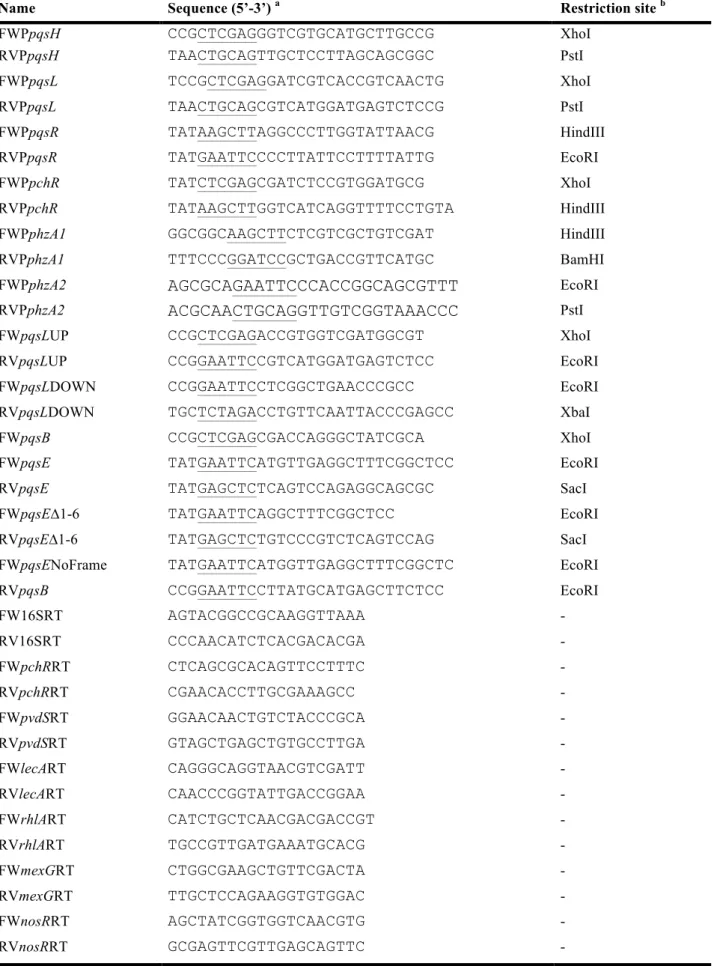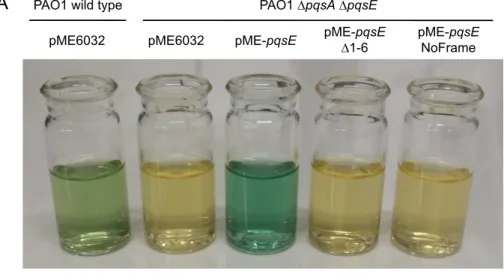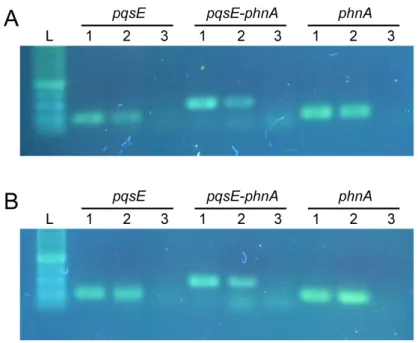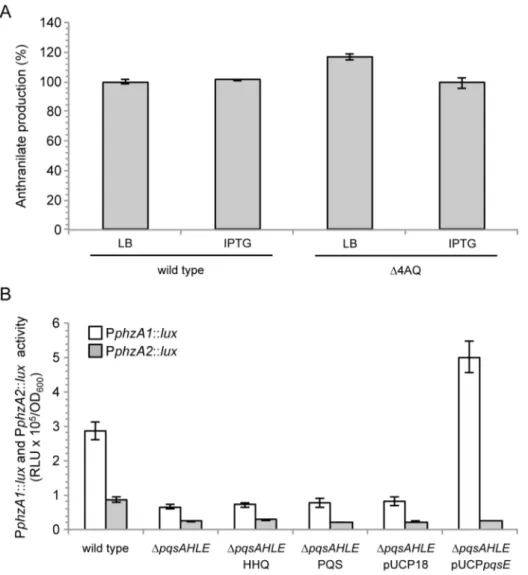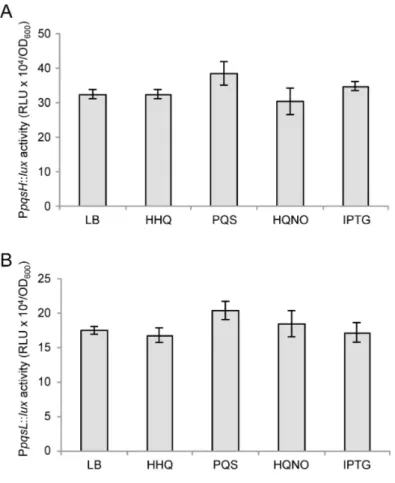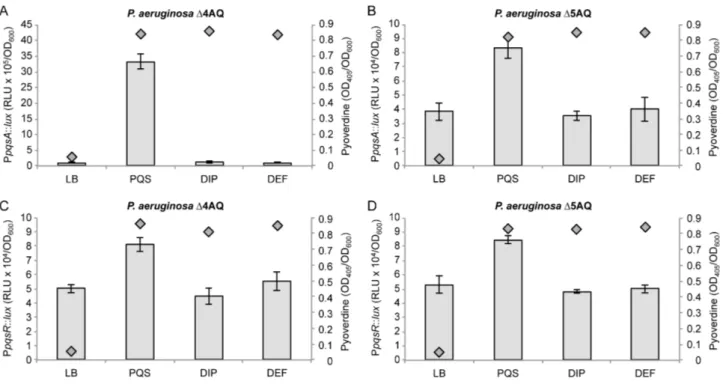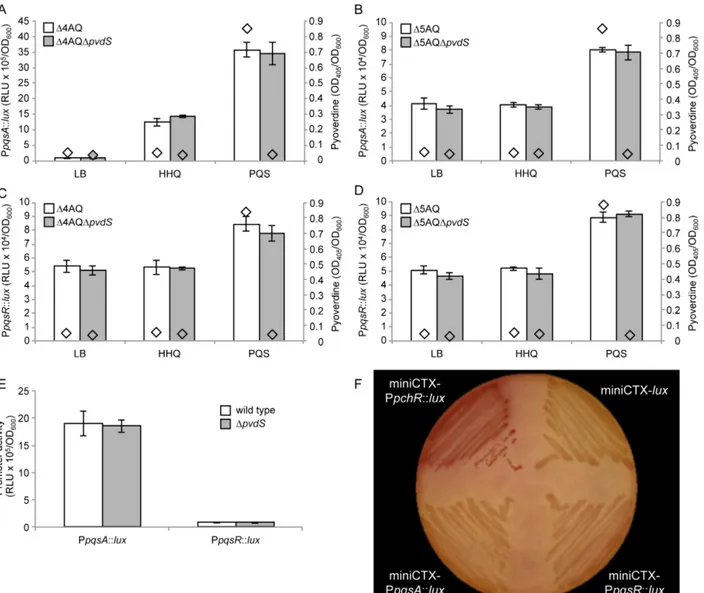Unravelling the Genome-Wide Contributions of Specific 2-Alkyl-4-Quinolones
and PqsE to Quorum Sensing in Pseudomonas aeruginosa
Giordano Rampioni
1,2*, Marilena Falcone
1,#a, Stephan Heeb
2, Emanuela Frangipani
1,2, Matthew P.
Fletcher
2, Jean-Frédéric Dubern
2, Paolo Visca
1, Livia Leoni
1, Miguel Cámara
2, Paul Williams
21
Department of Science, University Roma Tre, Rome, Italy
2
School of Life Sciences, Centre for Biomolecular Sciences, University of Nottingham,
Nottingham, UK
Supplementary Material
Table S1. Genes whose transcription is controlled by HHQ, PQS and/or PqsE
Table S2. Bacterial strains and plasmids
Table S3. Oligonucleotides
Fig. S1. Validation of the P. aeruginosa ∆4AQ strain
Fig. S2. The pqsE RNA transcript does not promote pyocyanin production
Fig. S3. RT-PCR analysis showing co-transcription of pqsE and phnA
Fig S4. PqsE does not affect anthranilate production and PphzA2 activity, while it positively
controls PphzA1 activity
Fig. S5. AQs and PqsE do not affect PpqsH and PpqsL activity
Fig. S6. The iron-chelators 2,2’-dipyridyl and deferiprone do not increase PpqsA activity
Fig. S7. Impact of Fur and PvdS on the PpqsA and PpqsR promoter regions
Table S1. Genes whose transcription is controlled by HHQ, PQS and/or PqsE
PA number a Gene name a HHQ b PQS c PqsE d Product name aPA0051 phzH 3.2 Potential phenazine-modifying enzyme
PA0083 tssB1 -5.1 TssB1
PA0084 tssC1 -3.5 TssC1
PA0129 bauD -5.5 Amino acid permease
PA0130 bauC -5.5 3-oxopropanoate dehydrogenase
PA0131 bauB -7.5 BauB
PA0132 bauA -6.9 Beta-alanine:pyruvate transaminase
PA0187∫‡ 6.0 Hypothetical protein
PA0243‡ 3.2 Probable transcriptional regulator
PA0263 hcpC -4.3 Secreted protein Hcp
PA0269∫‡ 3.3 Conserved hypothetical protein
PA0270‡ 2.8 Hypothetical protein
PA0271∫‡ 3.4 Hypothetical protein
PA0298 spuB -2.8 Glutamylpolyamine synthetase
PA0299 spuC -2.6 Polyamine:pyruvate transaminase
PA0303 spuG -2.8 Polyamine transport protein PotH
PA0328 aaaA -3.7 arginine-specific autotransporter, AaaA
PA0423 pasP 2.5 PasP
PA0431 2.7 Hypothetical protein
PA0432 sahH 2.9 S-adenosyl-L-homocysteine hydrolase
PA0471 fiuR 2.7 FiuR
PA0472 fiuI 2.5 FiuI
PA0480∫‡ 2.7 Probable hydrolase
PA0509 nirN -16.0 -16.0 NirN
PA0510 nirE -18.8 -13.1 NirE
PA0511 nirJ -50.3 -22.1 Heme d1 biosynthesis protein NirJ
PA0512 nirH -22.4 -14.4 NirH
PA0513 nirG -17.2 -13.5 NirG
PA0514 nirL -27.2 -16.1 Heme d1 biosynthesis protein NirL
PA0515 nirD -75.3 -26.8 Probable transcriptional regulator
PA0516 nirF -27.3 -12.8 Heme d1 biosynthesis protein NirF
PA0517 nirC -87.7 -21.5 Probable c-type cytochrome precursor
PA0518 nirM -109.9 -28.6 Cytochrome c551 precursor
PA0519 nirS -101.2 -41.9 Nitrite reductase precursor
PA0520 nirQ -4.7 -3.0 Regulatory protein NirQ
PA0521 nirO -3.6 -3.2 Probable cytochrome c oxidase subunit
PA0523 norC -32.4 -25.6 Nitric-oxide reductase subunit C
PA0524 norB -41.0 -34.3 Nitric-oxide reductase subunit B
PA0525 norD -7.2 -7.4 Probable denitrification protein NorD
PA0526 -20.1 -12.4 Hypothetical protein
PA0546 metK 3.0 Methionine adenosyltransferase
PA number a Gene name a HHQ b PQS c PqsE d Product name a
PA0792 prpD 2.9 Propionate catabolic protein PrpD
PA0794 -3.7 -3.2 Probable aconitate hydratase
PA0795 prpC -3.5 Citrate synthase 2
PA0796 prpB -4.6 Carboxyphosphonoenolpyruvate phosphonomutase
PA0848§ aphB 2.5 alkyl hydroperoxide reductase, AhpB
PA0852 cbpD 4.1 Chitin-binding protein CbpD precursor
PA0918 -14.3 Cytochrome b561
PA0931 pirA 2.6 Ferric enterobactin receptor PirA
PA0997*∫‡◊ pqsB 6.7 17.5 PqsB
PA0998*∫‡◊ pqsC 5.5 16.1 PqsC
PA0999*∫‡◊ pqsD 5.8 15.7 3-oxoacyl-[acyl-carrier-protein] synthase III
PA1000*∫◊ pqsE 22.8 Quinolone signal response protein
PA1001*∫◊ phnA 26.2 Anthranilate synthase component I
PA1002*∫◊ phnB 22.4 Anthranilate synthase component II
PA1070 braG -3.5 Branched-chain amino acid transport protein BraG
PA1071 braF -3.1 Branched-chain amino acid transport protein BraF
PA1072 braE -4.0 Branched-chain amino acid transport protein BraE
PA1073 braD -5.3 Branched-chain amino acid transport protein BraD
PA1134 3.3 Hypothetical protein
PA1172 napC -5.7 Cytochrome c-type protein NapC
PA1173 napB -8.9 Cytochrome c-type protein NapB precursor
PA1174§ napA -6.5 Periplasmic nitrate reductase protein NapA
PA1195 -3.4 Hypothetical protein
PA1212‡ 2.8 Probable MFS transporter
PA1213∫ 3.7 Hypothetical protein
PA1214 3.6 Hypothetical protein
PA1215 4.1 Hypothetical protein
PA1216* 4.9 Hypothetical protein
PA1217 5.8 Probable 2-isopropylmalate synthase
PA1218∫ 5.5 Hypothetical protein
PA1245§∫ aprX 3.9 AprX
PA1300 11.1 Probable sigma-70 factor, ECF subfamily
PA1301‡ 6.1 Probable transmembrane sensor
PA1318∫ cyoB 2.9 Cytochrome o-ubiquinol oxidase subunit I
PA1551 fixG -3.7 Probable ferredoxin
PA1562 acnA -2.6 Aconitate hydratase 1
PA1565 pauB2 -9.7 -3.8 FAD-dependent oxidoreductase
PA1583 sdhA -2.6 Succinate dehydrogenase (flavoprotein subunit)
PA1602 -2.7 Probable oxidoreductase
PA1659 hsiF2 -2.5 HsiF2
PA1706 pcrV 2.7 Type III secretion protein PcrV
PA1707 pcrH 3.1 Regulatory protein PcrH
PA1708 popB 5.6 Translocator protein PopB
PA number a Gene name a HHQ b PQS c PqsE d Product name a
PA1710 exsC 3.5 ExsC exoenzyme S synthesis protein C precursor
PA1711 exsE 3.1 ExsE
PA1712 exsB 2.6 Exoenzyme S synthesis protein B
PA1718 pscE 4.3 Type III export protein PscE
PA1869 2.8 Probable acyl carrier protein
PA1888 2.8 Hypothetical protein
PA1897 -3.1 Hypothetical protein
PA1901∫ phzC2 5.5 Phenazine biosynthesis protein PhzC
PA1902§ phzD2 7.5 Phenazine biosynthesis protein PhzD
PA1903∫ phzE2 8.8 Phenazine biosynthesis protein PhzE
PA1904 phzF2 10.3 Probable phenazine biosynthesis protein
PA1905 phzG2 9.7 Probable pyridoxamine 5'-phosphate oxidase
PA1912 femI 3.6 ECF sigma factor, FemI
PA1946 rbsB -2.6 Binding protein component precursor of ABC ribose transporter
PA2014 liuB -2.6 Methylcrotonyl-CoA carboxylase, beta-subunit
PA2030 3.7 Hypothetical protein
PA2031* 3.7 Hypothetical protein
PA2033∫ 17.6 Hypothetical protein
PA2034 5.5 Hypothetical protein
PA2041 -4.7 Amino acid permease
PA2066∫‡ 3.0 Hypothetical protein
PA2068∫ 2.7 Probable MFS transporter
PA2069*∫ 3.9 Probable carbamoyl transferase
PA2193* hcnA 3.6 Hydrogen cyanide synthase HcnA
PA2194* hcnB 3.1 Hydrogen cyanide synthase HcnB
PA2195* hcnC 3.0 Hydrogen cyanide synthase HcnC
PA2264 -3.4 Conserved hypothetical protein
PA2265 -3.7 Gluconate dehydrogenase
PA2274*∫ 5.4 Hypothetical protein
PA2300*∫◊ chiC 18.7 Chitinase
PA2383 4.5 Probable transcriptional regulator
PA2384§ 42.2 Hypothetical protein
PA2385 pvdQ 29.1 3-oxo-C12-homoserine lactone acylase PvdQ
PA2386 pvdA 113.8 L-ornithine N5-oxygenase
PA2389 pvdR 7.3 PvdR
PA2390 pvdT 4.1 PvdT
PA2391 opmQ 3.3 Probable outer membrane protein precursor
PA2392 pvdP 7.9 PvdP
PA2393 55.0 Probable dipeptidase precursor
PA2394 pvdN 45.6 PvdN
PA2395 pvdO 27.3 PvdO
PA2396 pvdF 49.0 Pyoverdine synthetase F
PA2397 pvdE 48.2 Pyoverdine biosynthesis protein PvdE
PA number a Gene name a HHQ b PQS c PqsE d Product name a PA2399 pvdD 18.2 Pyoverdine synthetase D
PA2400 pvdJ 21.9 PvdJ
PA2402 23.1 Probable non-ribosomal peptide synthetase
PA2403 4.7 Hypothetical protein
PA2404 3.6 Hypothetical protein
PA2405§ 3.9 Hypothetical protein
PA2406 3.4 Hypothetical protein
PA2407 4.6 Probable adhesion protein
PA2408 3.7 Probable ATP-binding component of ABC transporter
PA2409 3.5 Probable permease of ABC transporter
PA2410 3.0 Hypothetical protein
PA2411 30.2 Probable thioesterase
PA2412§∫ 70.7 Conserved hypothetical protein
PA2413∫ pvdH 43.1 L-2,4-diaminobutyrate:2-ketoglutarate 4-aminotransferase
PA2424 pvdL 26.2 PvdL
PA2425 pvdG 11.6 PvdG
PA2426 pvdS 43.9 Sigma factor PvdS
PA2427 21.3 Hypothetical protein
PA2444 glyA2 -3.9 Serine hydroxymethyltransferase
PA2448‡ 3.7 Hypothetical protein
PA2451 5.1 Hypothetical protein
PA2452 48.2 Hypothetical protein
PA2481 -2.9 Hypothetical protein
PA2482 -2.7 Probable cytochrome c
PA2509∫‡ catB 4.3 Muconate cycloisomerase I
PA2511‡ antR 3.2 AntR
PA2531 3.2 Probable aminotransferase
PA2554 -2.7 Probable short-chain dehydrogenase
PA2555 -2.8 Probable AMP-binding enzyme
PA2557 -3.3 Probable AMP-binding enzyme
PA2564 tam 4.6 Hypothetical protein
PA2565 3.5 Hypothetical protein
PA2570*∫◊ lecA 26.3 LecA lectin
PA2588 2.7 Probable transcriptional regulator
PA2682 3.0 Conserved hypothetical protein
PA2765 -2.9 Hypothetical protein
PA2862 lipA -8.7 Lactonizing lipase precursor
PA2953 -2.9 Electron transfer flavoprotein-ubiquinone oxidoreductase
PA3032§ snr1 5.4 Cytochrome c Snr1
PA3120 leuD -2.5 3-isopropylmalate dehydratase small subunit
PA3121 leuC -3.6 3-isopropylmalate dehydratase large subunit
PA3190 gltB -3.3 Probable binding protein component of ABC sugar transporter
PA3192 gltR -2.6 Two-component response regulator GltR
PA number a Gene name a HHQ b PQS c PqsE d Product name a
PA3300 fadD2 -2.5 Long-chain-fatty-acid-CoA ligase
PA3361*◊ lecB 8.5 Fucose-binding lectin LecB
PA3369* 3.1 Hypothetical protein
PA3391 nosR -4.6 -4.1 Regulatory protein NosR
PA3392* nosZ -72.7 -58.8 Nitrous-oxide reductase precursor
PA3393 nosD -8.8 -9.0 NosD protein
PA3394 nosF -6.3 -5.8 NosF protein
PA3395 nosY -3.9 -3.2 NosY protein
PA3396 nosL -3.4 -2.7 NosL protein
PA3407 hasAp 76.6 Heme acquisition protein HasAp
PA3408 hasR 6.4 Heme uptake outer membrane receptor HasR precursor
PA3410 hasI 7.6 HasI
PA3441 ssuF 10.2 Probable molybdopterin-binding protein
PA3444 ssuD 4.2 Conserved hypothetical protein
PA3452 mqoA 2.6 Malate:quinone oxidoreductase
PA3478* rhlB 3.6 Rhamnosyltransferase chain B
PA3479 rhlA 3.6 Rhamnosyltransferase chain A
PA3484 tse3 -2.6 Tse3
PA3520*§ 4.0 Hypothetical protein
PA3524 gloA1 -2.7 Lactoylglutathione lyase
PA3530 bfd 18.6 Bacterioferritin-associated ferredoxin Bfd
PA3568 ymmS -8.9 Probable acetyl-CoA synthetase
PA3569 mmsB -5.3 3-hydroxyisobutyrate dehydrogenase
PA3570 mmsA -3.9 Methylmalonate-semialdehyde dehydrogenase
PA3600 rpl36 3.0 Conserved hypothetical protein
PA3601 ykgM 2.7 Conserved hypothetical protein
PA3602 yerD -6.4 Conserved hypothetical protein
PA3709 -6.4 Probable MFS transporter
PA3710 -5.0 Probable GMC-type oxidoreductase
PA3734 4.8 Hypothetical protein
PA3784 -6.0 Hypothetical protein
PA3785 -7.0 Conserved hypothetical protein
PA3790 oprC -3.7 Putative copper transport outer membrane porin OprC
PA3841 exoS 2.6 Exoenzyme S
PA3842 spcS 3.9 Specific Pseudomonas chaperone for ExoS, SpcS
PA3866 2.6 Pyocin protein
PA3870 moaA1 -2.7 Molybdopterin biosynthetic protein A1
PA3872 narI -7.0 -5.0 Respiratory nitrate reductase gamma chain PA3873 narJ -3.6 -3.1 Respiratory nitrate reductase delta chain PA3874 narH -6.5 -3.8 Respiratory nitrate reductase beta chain
PA3899 fecI 3.4 FecI
PA3938 tauA 2.7 Probable periplasmic taurine-binding protein precursor
PA4023 eutP -4.5 Probable transport protein
PA number a Gene name a HHQ b PQS c PqsE d Product name a
PA4078* 12.1 Probable nonribosomal peptide synthetase
PA4131§ -5.8 Probable iron-sulfur protein
PA4132 -3.1 Conserved hypothetical protein
PA4133 ccoN -5.2 Cytochrome c oxidase subunit (cbb3-type)
PA4134‡ -6.1 Hypothetical protein
PA4140‡ 5.3 Hypothetical protein
PA4141*§‡ 4.4 5.2 Hypothetical protein
PA4142‡ 4.3 4.8 Probable secretion protein
PA4168 fpvB 4.0 Second ferric pyoverdine receptor FpvB
PA4175 prpL 3.7 PrpL, protease IV
PA4205*∫◊ mexG 25.0 Hypothetical protein
PA4206*∫◊ mexH 16.4 Probable RND efflux membrane fusion protein precursor
PA4207*∫◊ mexI 18.5 Probable RND efflux transporter
PA4208*∫◊ opmD 11.6 Probable outer membrane protein precursor
PA4209*∫◊ phzM 4.1 Probable phenazine-specific methyltransferase
PA4210◊ phzA 10.2 Probable phenazine biosynthesis protein
PA4211*◊ phzB 5.6 Probable phenazine biosynthesis protein
PA4217*§◊ phzS 9.0 Flavin-containing monooxygenase
PA4218§∫ ampP 22.6 AmpP
PA4219 yfpB 10.7 AmpO
PA4220§ fptB 30.3 Hypothetical protein
PA4221§∫‡ fptA 23.6 Fe(III)-pyochelin outer membrane receptor precursor
PA4222§∫‡ pchI 13.8 Probable ATP-binding component of ABC transporter
PA4223§ pchH 13.7 Probable ATP-binding component of ABC transporter
PA4224§ pchG 40.1 Pyochelin biosynthetic protein PchG
PA4225§∫‡ pchF 37.0 Pyochelin synthetase
PA4226§∫‡ pchE 28.0 Dihydroaeruginoic acid synthetase
PA4227∫‡ pchR 11.2 Transcriptional regulator PchR
PA4228§∫‡ pchD 34.1 Pyochelin biosynthesis protein PchD
PA4229§∫ pchC 31.5 Pyochelin biosynthetic protein PchC
PA4230§∫ pchB 47.3 Salicylate biosynthesis protein PchB
PA4231§∫‡ pchA 44.0 Salicylate biosynthesis isochorismate synthase
PA4236§ katA -5.5 Catalase
PA4333 fumA -3.4 Probable fumarase
PA4366 sodB -3.8 Superoxide dismutase
PA4370 icmP 2.6 Insulin-cleaving metalloproteinase outer membrane protein
PA4384 3.0 Hypothetical protein
PA4429 -2.9 Probable cytochrome c1 precursor
PA4430 -3.1 Probable cytochrome b
PA4431 -2.8 Probable iron-sulfur protein
PA4467 12.9 Hypothetical protein
PA4468§ sodA 89.4 Superoxide dismutase
PA4469§∫ orfX 136.5 OrfX
PA number a Gene name a HHQ b PQS c PqsE d Product name a
PA4471§∫ fagA 58.6 FagA
PA4500 -2.6 Probable binding protein component of ABC transporter
PA4501 opdD -5.4 Glycine-glutamate dipeptide porin OpdP
PA4502 -2.8 Probable binding protein component of ABC transporter
PA4519 speC 2.7 Ornithine decarboxylase
PA4570 57.4 Hypothetical protein
PA4587*§ ccpR -12.3 Cytochrome c551 peroxidase precursor
PA4613§‡ katB 2.7 Catalase
PA4623 2.5 Hypothetical protein
PA4648 cupE1 3.0 Pilin subunit CupE1
PA4708 phuT 4.2 Heme-transport protein, PhuT
PA4709 phuS 4.5 PhuS
PA4710 phuR 9.2 Heme/Haemoglobin uptake outer membrane receptor PhuR
PA4774 -2.5 Hypothetical protein
PA4810 fdnI -3.0 Nitrate-inducible formate dehydrogenase, gamma subunit
PA4811§ fdnH -4.5 Nitrate-inducible formate dehydrogenase, beta subunit
PA4812§ fdnG -5.3 Formate dehydrogenase-O, major subunit
PA4880§ -10.4 Probable bacterioferritin
PA4896 3.5 Probable sigma-70 factor, ECF subfamily
PA5058 phaC2 2.5 Poly(3-hydroxyalkanoic acid) synthase 2
PA5082 dguC -13.2 DguC
PA5098 hutH -3.5 Histidine ammonia-lyase
PA5100 hutU -3.2 Urocanase
PA5153 -2.6 Amino acid ABC transporter periplasmic binding protein
PA5154 -4.5 Probable permease of ABC transporter
PA5167 dctP -3.4 DctP
PA5168 dctQ -5.6 DctQ
PA5169 dctM -7.0 DctM
PA5300 cycB -3.4 Cytochrome c5
PA5355 glcD -3.5 Glycolate oxidase subunit GlcD
PA5380 gbdR -2.6 GbdR
PA5396 -4.3 Hypothetical protein
PA5397 -4.6 Hypothetical protein
PA5410 gbcA -5.7 GbcA
PA5460§ 3.7 Hypothetical protein
a PA number, gene name and product name are from the Pseudomonas Genome Database [13]. Genes previously reported controlled
by iron-starvation are in bold characters [40,41]; genes controlled by PQS via a PqsR-independent and iron starvation-independent signalling pathway(s) are underlined. *, genes whose transcription was altered in the ∆pqsR mutant with respect to the wild type strain [10]; §, genes whose transcription was altered upon exogenous PQS provision [28]; ∫, genes whose transcription was altered in the ∆pqsA mutant with respect to the wild type strain [11]; ‡, genes whose transcription was altered upon PqsE overexpression [11]; ◊, genes whose transcription was altered in the ∆pqsH mutant with respect to the wild type strain [23]. RND, Resistance-Nodulation-Cell division; MFS, major facilitator superfamily.
b Fold change in gene expression in P. aeruginosa PAO1 ∆4AQ grown in LB supplemented with 40 µM HHQ with respect to the
same strain grown in LB.
c Fold change in gene expression in P. aeruginosa PAO1 ∆4AQ grown in LB supplemented with 40 µM PQS with respect to the
same strain grown in LB.
d Fold change in gene expression in P. aeruginosa PAO1 ∆4AQ grown in LB supplemented with 1 mM IPTG (to induce PqsE
Table S2. Bacterial strains and plasmids
Strains/Plasmids Relevant characteristics and plasmids construction Reference/Source
E. coli
DH5α Cloning strain. [55]
S17.1λpir Conjugative strain for suicide plasmids. [56]
H1717 Mutant strain carrying the PfhuF::lacZ transcriptional fusion
that does not produce the siderophore enterochelin. Used for the Fur titration assay (FurTA).
[51]
P. aeruginosa
PAO1 Nottingham collection wild type strain.
∆pqsA ∆pqsH pqsA and pqsH double mutant of strain PAO1. [27]
∆pqsA ∆pqsE pqsA and pqsE double mutant of strain PAO1. [11]
∆pqsR pqsR mutant of strain PAO1. This study
∆4AQ Quadruple mutant of PAO1 carrying in frame clear deletions
of the pqsA, pqsH, and pqsL genes, in which pqsE is under the control of an IPTG-inducible promoter.
This study
∆5AQ Quintuple mutant of PAO1 carrying in frame clear deletions
of the pqsA, pqsH, pqsL, and pqsR genes, in which pqsE is under the control of an IPTG-inducible promoter.
This study
∆pvdS pvdS mutant of strain PAO1. This study
∆4AQ∆pvdS ∆4AQ strain carrying a deletion of the pvdS gene. This study
∆5AQ∆pvdS ∆5AQ strain carrying a deletion of the pvdS gene. This study
∆pqsAHLE Quadruple mutant of PAO1 carrying in frame clear deletions
of the pqsA, pqsH, pqsL and pqsE genes.
This study
Plasmids
pBluescript II KS(+) Cloning vector; ColE1 replicon; ApR. Stratagene
pDM4 Suicide vector; sacBR; oriR6K; CmR. [57]
pME6032 pVS1-p15A shuttle expression (IPTG-inducible) vector, TcR. [58]
miniCTX-lux Promoter-probe vector containing the luxCDABE operon;
TcR.
[59]
pEX∆pvdS pEX18 derivative used to introduce the pvdS mutation in
PAO1 wild type, ∆4AQ and ∆5AQ.
[53]
pDM4pqsEind pDM4 derivative for the generation of the pqsE-inducible
strain ∆4AQ.
Strains/Plasmids Relevant characteristics and plasmids construction Reference/Source
pDM4∆pqsE pDM4 derivative for the generation of the PAO1 ∆pqsAHLE
mutant strain.
[11]
pDM4∆pqsR pDM4 derivative used to introduce the pqsR mutation in
PAO1 wild type and in the ∆5AQ strain.
[24]
miniCTX-PpqsA::lux miniCTX-lux derivative used to insert the PpqsA::lux fusion
in the chromosome of different P. aeruginosa strains.
[27]
pUCP18 pUC18 derivative containing a stabilising fragment for
maintenance in Pseudomonas; ApR, E. coli / CbR, P.
aeruginosa.
[60]
pUCPpqsE pUCP18 derivative for pqsE complementation; ApR. [11]
pBSpqsLUP The DNA fragnment encompassing the upstream region of
the pqsL gene originated with primers FWpqsLUP and RVpqsLUP (Table S3) was cloned in pBluescript II KS(+) by XhoI-EcoRI restriction.
This study
pBSpqsLDOWN The DNA fragment encompassing the downstream region of
the pqsL gene originated with primers FWpqsLDOWN and RVpqsLDOWN (Table S3) was cloned in pBluescript II KS(+) by EcoRI-XbaI restriction.
This study
pDM4∆pqsL pDM4-derived plasmid used to introduce the pqsL mutation
in P. aeruginosa ∆pqsA ∆pqsH. It contains the DNA fragments encompassing the upstream region pqsL (extracted by XhoI-EcoRI restriction from pBSpqsLUP) and the downstream region of pqsL (extracted by EcoRI-XbaI restriction from pBSpqsLDOWN), and cloned in pDM4 by XhoI-XbaI.
This study
miniCTX-PpqsH::lux miniCTX-lux derivative used to insert the PpqsH::lux fusion
in the chromosome of different P. aeruginosa strains. Obtained by cloning in miniCTX-lux with restriction enzymes XhoI-PstI a DNA region encompassing the PpqsH promoter amplified with primers FWPpqsH and RVPpqsH (Table S3).
This study
miniCTX-PpqsL::lux miniCTX-lux derivative used to insert the PpqsL::lux fusion
in the chromosome of different P. aeruginosa strains. Obtained by cloning in miniCTX-lux with restriction enzymes XhoI-PstI a DNA region encompassing the PpqsL promoter amplified with primers FWPpqsL and RVPpqsL (Table S3).
Strains/Plasmids Relevant characteristics and plasmids construction Reference/Source
miniCTX-PpqsR::lux miniCTX-lux derivative used to insert the PpqsR::lux fusion
in the chromosome of different P. aeruginosa strains. Obtained by cloning in miniCTX-lux with restriction enzymes HindIII-EcoRI a DNA region encompassing the PpqsR promoter amplified with primers FWPpqsR and RVPpqsR (Table S3).
This study
miniCTX-PpchR::lux miniCTX-lux derivative used to test the ability of Fur to bind
the PpchR promoter (FurTA; posistive control). Obtained by cloning in miniCTX-lux with restriction enzymes XhoI-HindIII a DNA region encompassing the PpchR promoter amplified with primers FWPpchR and RVPpchR (Table S3).
This study
miniCTX-PphzA1::lux miniCTX-lux derivative used to insert the PphzA1::lux fusion into the chromosome of P. aeruginosa ∆pqsAHLE. Obtained by cloning in miniCTX-lux with restriction enzymes HindIII-BamHI a DNA region encompassing the PphzA1 promoter amplified with primers FWPphzA1 and RVPphzA1 (Table S3).
This study
miniCTX-PphzA2::lux miniCTX-lux derivative used to insert the PphzA2::lux fusion into the chromosome of P. aeruginosa ∆pqsAHLE. Obtained by cloning in miniCTX-lux with restriction enzymes EcoRI-PstI a DNA region encompassing the PphzA2 promoter amplified with primers FWPphzA2 and RVPphzA2 (Table S3).
This study
pME-pqsE pME6032 derivative for the IPTG-dependent expression on
pqsE. Obtained by cloning in pME6032 with restriction
enzymes EcoRI-SacI a DNA region encompassing the pqsE gene amplified with primers FWpqsE and RVpqsE (Table S3).
This study
pME-pqsE∆1-6 pME6032 derivative for the IPTG-dependent expression of a
mutated variant of pqsE lacking the first two codons (ATGTTG). Obtained by cloning in pME6032 with restriction enzymes EcoRI-SacI a DNA region encompassing the pqsE gene amplified with primers FWpqsE∆1-6 and RVpqsE∆1-6 (Table S3).
Strains/Plasmids Relevant characteristics and plasmids construction Reference/Source
pME-pqsENoFrame pME6032 derivative for the IPTG-dependent expression of a
mutated variant of pqsE out of frame. Obtained by cloning in pME6032 with restriction enzymes EcoRI-SacI a DNA region encompassing the pqsE gene amplified with primers FWpqsENoFrame and RVpqsE (Table S3).
This study
Additional references for Table S2:
55. Grant SG, Jessee J, Bloom FR, Hanahan D. Differential plasmid rescue from transgenic mouse DNAs into Escherichia coli methylation-‐restriction mutants. Proc Natl Acad Sci USA. 1990;87:4645-‐9.
56. Simon R, Priefer U, Puhler A. A broad host range mobilization system for in vivo genetic-‐engineering: transposon mutagenesis in Gram-‐negative bacteria. Biotechnology. 1983;1:784-‐91.
57. Milton DL, O'Toole R, Horstedt P, Wolf-Watz H. Flagellin A is essential for the virulence of Vibrio anguillarum. J Bacteriol. 1996;178:1310-9.
58. Heeb S, Blumer C, Haas D. Regulatory RNA as mediator in GacA/RsmA-dependent global control of exoproduct formation in Pseudomonas fluorescens CHA0. J Bacteriol. 2002;184:1046-56.
59. Becher A, Schweizer HP. Integration-‐proficient Pseudomonas aeruginosa vectors for isolation of single-‐copy chromosomal lacZ and lux gene fusions. Biotechniques. 2000;29:948-‐50.
Table S3. Oligonucleotides
Name Sequence (5’-3’) a Restriction site b
FWPpqsH
CCGCTCGAGGGTCGTGCATGCTTGCCG
XhoI RVPpqsHTAACTGCAGTTGCTCCTTAGCAGCGGC
PstI FWPpqsLTCCGCTCGAGGATCGTCACCGTCAACTG
XhoI RVPpqsLTAACTGCAGCGTCATGGATGAGTCTCCG
PstI FWPpqsRTATAAGCTTAGGCCCTTGGTATTAACG
HindIII RVPpqsRTATGAATTCCCCTTATTCCTTTTATTG
EcoRI FWPpchRTATCTCGAGCGATCTCCGTGGATGCG
XhoI RVPpchRTATAAGCTTGGTCATCAGGTTTTCCTGTA
HindIIIFWPphzA1
GGCGGCAAGCTTCTCGTCGCTGTCGAT
HindIIIRVPphzA1
TTTCCCGGATCCGCTGACCGTTCATGC
BamHIFWPphzA2
AGCGCAGAATTCCCACCGGCAGCGTTT
EcoRIRVPphzA2
ACGCAACTGCAGGTTGTCGGTAAACCC
PstIFWpqsLUP
CCGCTCGAGACCGTGGTCGATGGCGT
XhoIRVpqsLUP
CCGGAATTCCGTCATGGATGAGTCTCC
EcoRIFWpqsLDOWN
CCGGAATTCCTCGGCTGAACCCGCC
EcoRIRVpqsLDOWN
TGCTCTAGACCTGTTCAATTACCCGAGCC
XbaIFWpqsB
CCGCTCGAGCGACCAGGGCTATCGCA
XhoIFWpqsE
TATGAATTCATGTTGAGGCTTTCGGCTCC
EcoRIRVpqsE
TATGAGCTCTCAGTCCAGAGGCAGCGC
SacIFWpqsE∆1-6
TATGAATTCAGGCTTTCGGCTCC
EcoRIRVpqsE∆1-6
TATGAGCTCTGTCCCGTCTCAGTCCAG
SacIFWpqsENoFrame
TATGAATTCATGGTTGAGGCTTTCGGCTC
EcoRIRVpqsB
CCGGAATTCCTTATGCATGAGCTTCTCC
EcoRI FW16SRTAGTACGGCCGCAAGGTTAAA
- RV16SRTCCCAACATCTCACGACACGA
- FWpchRRTCTCAGCGCACAGTTCCTTTC
- RVpchRRTCGAACACCTTGCGAAAGCC
- FWpvdSRTGGAACAACTGTCTACCCGCA
- RVpvdSRTGTAGCTGAGCTGTGCCTTGA
- FWlecARTCAGGGCAGGTAACGTCGATT
- RVlecARTCAACCCGGTATTGACCGGAA
- FWrhlARTCATCTGCTCAACGACGACCGT
- RVrhlARTTGCCGTTGATGAAATGCACG
- FWmexGRTCTGGCGAAGCTGTTCGACTA
- RVmexGRTTTGCTCCAGAAGGTGTGGAC
- FWnosRRTAGCTATCGGTGGTCAACGTG
- RVnosRRTGCGAGTTCGTTGAGCAGTTC
-Name Sequence (5’-3’) a Restriction site b FWhcpCRT
TATCAGGAAGGCCACGAGGA
- RVhcpCRTCCACTGGATCTCGACCTTGG
- FWaprXRTCTGCCGATCAACGTCTCCTT
- RVaprXRTTACCGTAGAACTTGGCGCTG
- FWsodARTGCTGACCATGGAGATCCACC
- RVsodARTCGACATCACGGTCCAGAACA
- FWpqsERTCGGTGTTCCTGCTGCGTC
- RVpqsERTGACGCCAGGACCTGTACG
- FWphnARTGCGACATGCTCAAGGTCGAT
- RVphnARTCTGCCGCGATAGCCATCTT
- FWpqsE-phnAGTGGGCAGAGCGTCGACT
- RVpqsE-phnAGTGCGGTACTCCAGACTTTC
-a Engineered restriction sites are underlined. b -, no restriction site introduced.
Fig S1. Validation of the P. aeruginosa ∆4AQ strain
(A) Levels of HHQ (white bars), PQS (light-grey bars) and HQNO (dark-grey bars) quantified by
LC-MS/MS analysis in culture supernatants of P. aeruginosa ∆4AQ grown in LB or in LB
supplemented with 40 µM HHQ, PQS, or HQNO, or with 1 mM IPTG, as indicated. AQ levels
were quantified in supernatants from three independent cultures grown to OD
6001.5. (B) Fold
change in pqsE transcript levels measured by Real Time PCR in RNA extracted from ∆4AQ strains
grown as in (A). Data were normalized to the pqsE RNA level in the wild type. (C) Growth curves
of P. aeruginosa ∆4AQ grown in LB or in LB supplemented with 40 µM HHQ, PQS, or HQNO, or
with 1 mM IPTG, as indicated.
Fig S2. The pqsE RNA transcript does not promote pyocyanin production
Pyocyanin production (A) and pqsE RNA levels measured by Real Time PCR (B) in P. aeruginosa
∆pqsA ∆pqsE double mutant strains carrying the pME6032 empty vector or pME6032-derivative
plasmids for IPTG-inducible expression of wild type pqsE (pME-pqsE), or pqsE mutated variants
lacking the first two codons (pME-pqsE∆1-6) or with a nucleotide insertion after the ATG to alter
the protein frame (pME-pqsENoFrame). Culture supernatants and total RNAs are from the
indicated strains grown to an OD
600of 1.5 in LB supplemented with 1 mM IPTG. For the Real time
PCR analysis, data are normalized to the pqsE RNA level measured in parallel in the P. aeruginosa
PAO1 wild type.
1000 1 10 0.001 re la tive p qsE RNA le ve l with re sp ect to P AO 1 w ild typ e pME6 03 2 pME6032 pME-pqsE
A
B
pME6032 pME6032 pME-pqsE pME-pqsE NoFrame
100
0.01 0.1
pME-pqsE NoFrame
PAO1 wild type PAO1 ∆pqsA ∆pqsE
PAO1 ∆pqsA ∆pqsE pME-pqsE
∆1-6
pME-pqsE ∆1-6


